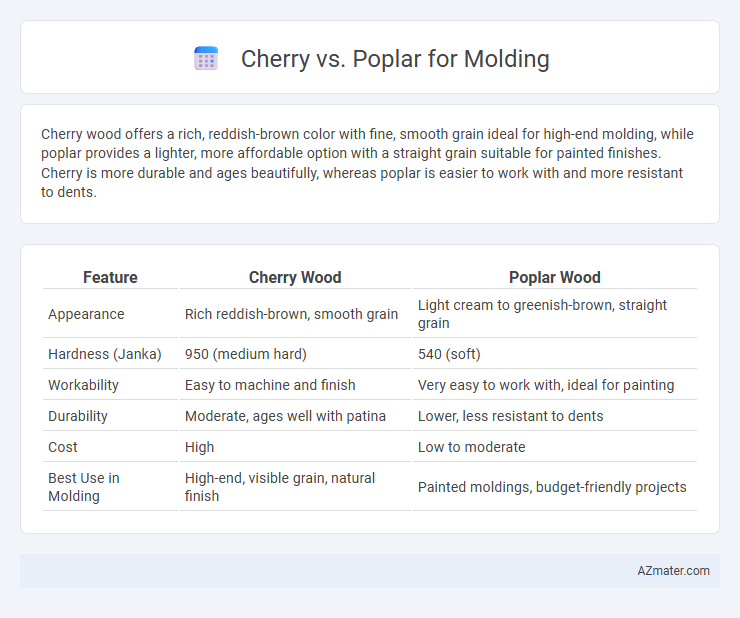Cherry wood offers a rich, reddish-brown color with fine, smooth grain ideal for high-end molding, while poplar provides a lighter, more affordable option with a straight grain suitable for painted finishes. Cherry is more durable and ages beautifully, whereas poplar is easier to work with and more resistant to dents.
Table of Comparison
| Feature | Cherry Wood | Poplar Wood |
|---|---|---|
| Appearance | Rich reddish-brown, smooth grain | Light cream to greenish-brown, straight grain |
| Hardness (Janka) | 950 (medium hard) | 540 (soft) |
| Workability | Easy to machine and finish | Very easy to work with, ideal for painting |
| Durability | Moderate, ages well with patina | Lower, less resistant to dents |
| Cost | High | Low to moderate |
| Best Use in Molding | High-end, visible grain, natural finish | Painted moldings, budget-friendly projects |
Introduction to Cherry and Poplar for Molding
Cherry and poplar are popular hardwoods used in molding due to their distinct characteristics and finishing capabilities. Cherry offers a rich, warm reddish-brown tone and tight grain, making it ideal for high-end, elegant moldings that darken beautifully with age. Poplar features a lighter, pale color and smoother texture, providing an affordable, versatile option that accepts paint and stains well for customizable molding designs.
Wood Characteristics: Cherry vs Poplar
Cherry wood features a rich, warm reddish-brown hue that darkens with age, offering a smooth grain and excellent durability ideal for high-end molding. Poplar, by contrast, exhibits a lighter color with a subtle greenish undertone and a softer, more uniform grain, making it easier to machine but less resistant to dents and scratches. The natural hardness of cherry surpasses poplar, resulting in a more robust molding option that withstands wear while developing a distinctive patina over time.
Color and Appearance Differences
Cherry molding exhibits a rich, warm reddish-brown hue that deepens with age and exposure to light, offering a smooth, fine grain pattern with occasional natural streaks enhancing its luxurious appearance. Poplar molding features a lighter, more muted cream to pale greenish-brown color with a subtle straight grain and occasional woody streaks, providing a simpler, more uniform look ideal for painted finishes. The color stability of cherry makes it preferable for natural-stain applications, while poplar's neutrality suits versatile design schemes requiring customized coloration.
Strength and Durability Comparison
Cherry wood offers moderate strength with a Janka hardness of 950, making it resistant to dents and scratches while providing a smooth finish for molding. Poplar has a lower Janka hardness around 540, indicating it is softer and less durable against impacts but easier to machine and paint. For applications demanding long-lasting, resilient molding, cherry outperforms poplar in strength and durability, though poplar remains suitable for less demanding decorative uses.
Workability and Ease of Cutting
Cherry offers excellent workability with a smooth grain that cuts cleanly, making it ideal for detailed molding work. Poplar is softer and easier to cut, allowing for faster shaping and less tool wear, but it may require more finishing effort due to its tendency to splinter. Both woods respond well to hand and power tools, but cherry's fine texture provides a superior finish with less sanding.
Finish and Stain Compatibility
Cherry wood offers a rich, warm finish that deepens beautifully over time, making it ideal for molding with natural or dark stains. Poplar, known for its fine grain and pale color, provides a smooth surface that accepts paint and stains evenly, though it may require a primer for best results with darker stains. Both woods offer good stain compatibility, but Cherry's natural color enhances the final appearance more seamlessly in stained moldings.
Cost and Availability Factors
Cherry wood offers a rich, warm color and fine grain but typically comes at a higher cost due to its slower growth and limited availability compared to poplar. Poplar is more affordable and widely available, making it a popular choice for budget-conscious molding projects, though it lacks the natural elegance and durability of cherry. Cost efficiency and ease of sourcing make poplar a practical option, while cherry is preferred for premium, high-end finishes.
Environmental Impact and Sustainability
Cherry wood, known for its durability and fine grain, is often sourced from slower-growing hardwood trees, which may lead to concerns about deforestation and longer replenishment periods in sustainable forestry. Poplar, a fast-growing and widely available soft hardwood, has a lower environmental footprint due to its rapid growth and efficient carbon sequestration, making it a preferred choice for eco-conscious molding projects. Choosing poplar over cherry can significantly reduce environmental impact by supporting sustainable forestry and minimizing habitat disruption.
Ideal Applications for Each Wood
Cherry molding excels in fine furniture and interior trim due to its rich, warm reddish-brown color and smooth grain, making it ideal for decorative, high-end applications. Poplar molding is more suitable for painted projects such as baseboards, door casings, and window trims because of its uniform texture and affordability. Both woods offer stability, but poplar's ease of machining and lower cost make it preferred for large-scale or budget-conscious molding installations.
Final Verdict: Cherry or Poplar for Molding?
Cherry offers rich color and fine grain that enhances the elegance and durability of molding, making it ideal for high-end, classic interiors. Poplar provides an economical, lightweight option with smooth workability and consistent paint absorption, suited for budget-friendly or painted molding projects. For long-lasting beauty and natural warmth, Cherry is preferred; for cost-effective versatility and easy finishing, Poplar is the better choice.

Infographic: Cherry vs Poplar for Molding
 azmater.com
azmater.com